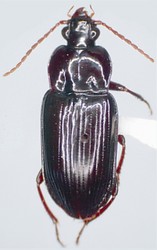Metoncidus
Kipling WillIntroduction
This genus was originally described by Bates (1871) for the single species Metoncidus tenebrionides and classified with loxandrine genera (Bates 1872), the loxandrine series (Allen & Ball 1980). This small and obscure genus was recently revised (Will 2004) and two more species described.
Little is known about the life history of these beetles but some M. epiphytus specimens have been collected by insecticide fogging, and the single specimen of M. gracilus was found under bark. Additionally, M. gracilus has been collected in "swamp forest", at a locality that was a marshy area of very low relief dominated by several large patches of Heliconia L., and surrounded by very dense growths of trees and shrubs noticeably different from those on adjacent areas of higher relief (S.J. ASHE, in litt.).
Characteristics
Separated from all Loxandrini in South America by the following combination of characters: elytral plica externally evident; third elytral interval with 5-10 setae in the apical half or third; pronotum wider than long with rounded lateral margins. Males of M. tenebrionides and M. epiphytus do not have the obliquely expanded protarsomeres found in most, but not all, males in Loxandrini.
Key to adult specimens of Metoncidus species
- 1. Elytral interval one with 6-8 setigerous punctures in the apical third of elytron; interval three (and in or touching stria two) with 8-10 setae in the apical third of elytron.2
- 1'. Elytral interval one with 0-1 setigerous punctures at the midpoint on elytron; interval three with 5 setigerous punctures in apical half of elytron. M. gracilus Will
- 2(1). Elytral interval five with 5-6 setigerous punctures; interval seven with 2 setigerous punctures. M. tenebrionides Bates
- 2'. Elytral intervals five and seven glabrous. M. epiphytus Will
Discussion of Phylogenetic Relationships
The relationship of this genus to other loxandrines is not resolved. It is most likely related to some South American Loxandrus or perhaps some Adrimus. Monophyly of this genus seems very likely given what is probably a derived body form (elongate and parallel-sided) and unusual pattern of additional setae on the elytra (plurisetose intervals), male venter (4 setae on sterna VII) and mesofemora shared by all species. None of these character states are found in putative near relatives, e.g. Loxandrus.
Title Illustrations

| Scientific Name | Metoncidus epiphytus |
|---|---|
| Specimen Condition | Dead Specimen |
| Identified By | K.Will |
| Sex | Male |
| Life Cycle Stage | Adult |
| View | Dorsal |
| Size | 9.6mm |
| Collection | USNM |
| Type | Paratype |
| Image Use |
 This media file is licensed under the Creative Commons Attribution License - Version 3.0. This media file is licensed under the Creative Commons Attribution License - Version 3.0.
|
| Copyright |
© Kipling Will

|
About This Page
Kipling Will

University of California, Berkeley, California, USA
Correspondence regarding this page should be directed to Kipling Will at
Page copyright © 2006 Kipling Will
 Page: Tree of Life
Metoncidus.
Authored by
Kipling Will.
The TEXT of this page is licensed under the
Creative Commons Attribution License - Version 3.0. Note that images and other media
featured on this page are each governed by their own license, and they may or may not be available
for reuse. Click on an image or a media link to access the media data window, which provides the
relevant licensing information. For the general terms and conditions of ToL material reuse and
redistribution, please see the Tree of Life Copyright
Policies.
Page: Tree of Life
Metoncidus.
Authored by
Kipling Will.
The TEXT of this page is licensed under the
Creative Commons Attribution License - Version 3.0. Note that images and other media
featured on this page are each governed by their own license, and they may or may not be available
for reuse. Click on an image or a media link to access the media data window, which provides the
relevant licensing information. For the general terms and conditions of ToL material reuse and
redistribution, please see the Tree of Life Copyright
Policies.
- First online 07 July 2006
- Content changed 07 July 2006
Citing this page:
Will, Kipling. 2006. Metoncidus. Version 07 July 2006 (under construction). http://tolweb.org/Metoncidus/51488/2006.07.07 in The Tree of Life Web Project, http://tolweb.org/








 Go to quick links
Go to quick search
Go to navigation for this section of the ToL site
Go to detailed links for the ToL site
Go to quick links
Go to quick search
Go to navigation for this section of the ToL site
Go to detailed links for the ToL site